We certainly made the right decision on the morning of the 18th July. The previous day we had been touring Block 1 of Yala National Park, seeing very little. Yala is the worst nightmare of anyone who likes to watch wildlife in peace and in near-solitude, as no less than 125 Jeeps were crammed into this tiny section of the park that day.
However, the following morning we decided to go that extra bit further to Lunugamvehera National Park, which is attached to Yala however significantly less popular. I have no idea why that is, because as soon as we entered the park were we racing towards our first Leopard sighting of the day.

We had brilliant views of this Leopard, much better than I’ve ever had before. In most other places where Leopards are found, there are other big cats inhabiting the area which drive the leopards into cover for a lot of the day and they become very shy. In Africa, it is lions and in India, there are Tigers. However, in Sri Lanka, there are no predators larger than Leopards and therefore they’re far more relaxed. We were able to watch this Leopard for a long time as it rested within a thin thicket, before getting up and moving slowly into the shade of a tree where it would probably spend the first few hours of the Sri Lankan day-time heat.
Lunugamvehera is not a huge park, and therefore we made a few circuits during the day. There are always new things to see on every circuit, such as Lesser Adjutants and a Stripe-necked Mongoose on the dry river bed, a pair of Stork-billed Kingfishers above a beautiful secluded river, and on the open plains an Indian Roller perched on a bare tree for all to see.

Stripe-necked Mongoose

Lesser Adjutant
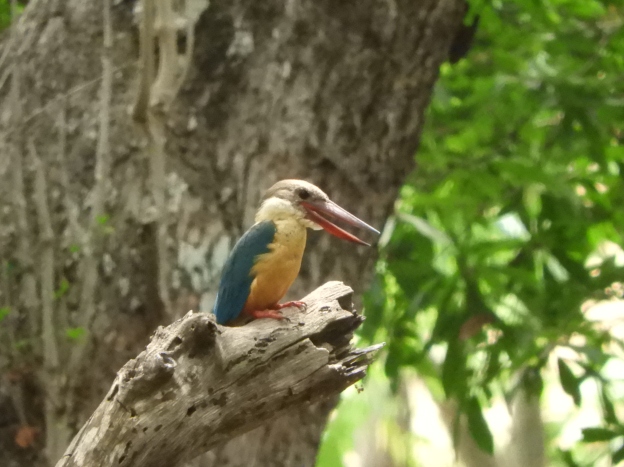
Stork-billed Kingfisher

Indian Roller
The second circuit was a little more exciting than the others, however. We were driving through the arid woodland when the guides noticed huge tracks on the side of the road that could only belong to one animal: a Sloth Bear! We increased our speed slightly as we drove in the direction the rather fresh tracks were heading, and after a bit of driving back-and-forth we heard from the other vehicle that they had just seen the Sloth Bear heading our way. We waited on the road and sure enough, we managed to spot a bear slowly ambling through the small trees towards the road in front of us. As it reached the road it increased its speed suddenly and lolloped across the track: a wonderful sight.
The rest of the day in the park continued as one would expect it to in the searing heat of the Sri Lankan arid zone. There was not too much happening mammal-wise, although as the sun and the temperatures began to sink, that all changed.
The Jeep drivers and the local guides all know each other really well, and therefore an efficient network is maintained that allows drivers to know about sightings in the vicinity. This came into play very nicely as our Jeep driver became aware of a Leopard that had just been seen near the reservoir in the centre of the park.
It’s a huge reservoir, with an impressive dam that is featured on Sri Lankan currency (the 5000 rupee note). It is surrounded by a forest of skeletons, the remains of the forest that had stood in the area before the construction of the dam. The washed-out trees still stand sturdy like statues, creating a unique landscape, dotted with large ponds left behind by the receding water of the dry season. These ponds are full of a plethora of water birds, such as the Painted Storks struggling with fish far too large and the Indian Pond Herons chasing each other around the muddy edges.

The bird-filled ponds

Indian Pond Heron
It was just after we pulled up beside one of these ponds that we spotted the Leopard strolling nonchalantly towards rim of the pond basin – scattering the storks, herons, plovers and ibises – where it lay down. It just seemed completely oblivious to the vehicle, and everything else around it. As the setting sun cast an awe-inspiring glow over the Leopard’s beautiful coat and the bizarre landscape, it really was a memorable moment.


Unfortunately, we soon had to get going to avoid being fined for a late exit. However, even as we were rushing back to the gates, our experience in Lunugamvehera was not over. All of a sudden, one of the guides knocked three times on the side of the vehicle, meaning ‘stop’. As we halted and began to reverse, none other than our third Leopard of the day came into view. It was drinking from a watering-hole no more than 15-20 metres from the road! An amazing end to a brilliant day in Sri Lanka.
The following morning, as we were leaving our hotel at Yala, I realised that we only had a limited amount of time left in Sri Lanka. However, I think we had saved the best until last. We were leaving Yala for the Sinharaja Rainforest: a serious birder’s dream and a leech-hater’s worst nightmare!

We were lucky to have two full days within the rainforest. My ambition for the trip as a whole was to manage to see as many of the endemics as possible, and we were already doing well. I had 13 left to see, and all of them could be found in the Sinharaja Rainforest and the surrounding area. It would be very tricky to see them all; however I would try my best.
Entering the Sinharaja Rainforest with a guide is compulsory, and the tour leaders made sure that we had a guide that would be able to show us as much of our target wildlife as possible. It turned out that the leaders had made a very good choice; within only about 45 minutes we had already seen a number of the target birds, including Green-billed Coucal, Sri Lanka Blue Magpie, Sri Lanka Myna and Sri Lanka Crested Drongo. This was because it’s a long drive up from the ticket counter to the reserve entrance, only about 1km however incredibly bumpy due to the floods the month before. We were travelling in a Toyota Pickup, meaning that our local guide was able to stand up in the back and spot all the birds that we would otherwise have missed!
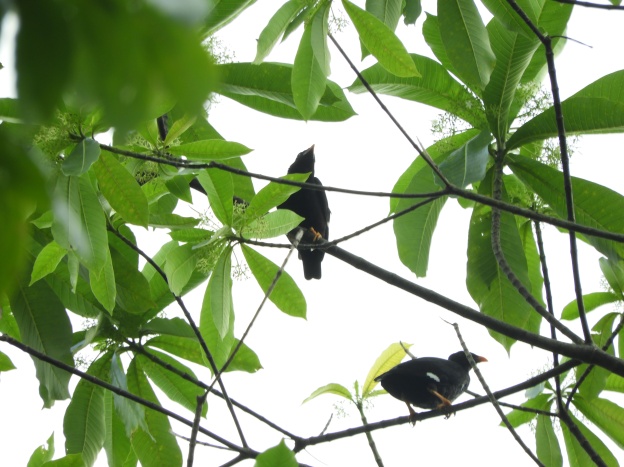
Sri Lanka Myna
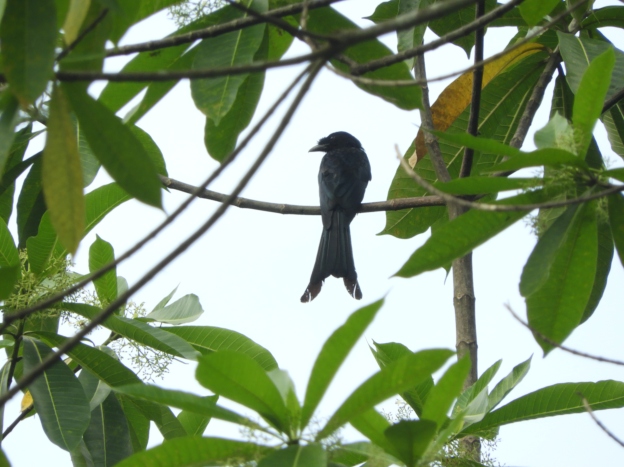
Sri Lanka Crested Drongo
By the time we arrived at the entrance it was around 8am and too late for the morning activity; however I only had 9 more endemics to see. Although due to the rainforest canopy keeping out a lot of the hot sun, birds are active to some extent throughout most of the day. Many species form bird waves that travel through the forest feeding on anything in their path. These we were actively seeking out, as they almost always have a few goodies among them!
It wasn’t long before we came across our first bird wave of the morning. The bird waves are usually dominated by Orange-billed Babblers, and Ashy-headed Laughing-thrushes were also a key part of them (another new endemic!). We were also able to add Red-faced Malkoha to our list! Unfortunately, birds in the bird wave are always quite mobile; the rainforest is thick with vegetation, meaning that these birds were incredibly hard to take photos of!
After the bird wave passed through, it was almost as if it was becoming night-time! We heard two and possibly even three Spot-bellied Eagle-owls began to call to each other. It was quite a surreal experience! Meanwhile, our guide was down among spiny vines in a large, deep ditch trying to locate another bird of the night, which is known to roost here in roughly the same place every day. These were Sri Lankan Frogmouths, a near endemic, and it was great to be able to see them at such close quarters. The males and the females are very sexually dimorphic, which the males being the more drab and dull of the two. This is because he is in charge of incubating the eggs.

Sri Lanka Frogmouths, Male (L), Female (R)
The next bird wave came through slowly afterwards, with more Red-faced Malkohas and Ashy-headed Laughing-thrushes in the mix. And after being shown a particularly co-operative Spot-winged Thrush, I only had 6 more species to get!
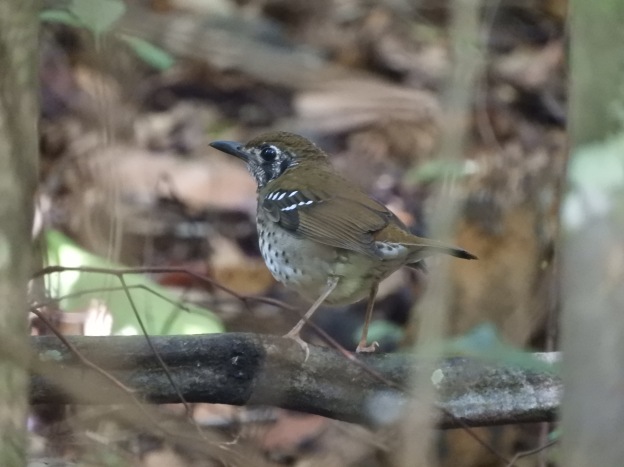
Spot-winged Thrush
Finally, we noticed that the 3rd and final bird wave was coming through. And it carried a surprise! I noticed a small, brown bird fly up on round wings onto a branch where it was half-hidden. ‘Owl’, I exclaimed! Despite all my efforts, I was unable to get anyone else onto it other than the guides. Thank goodness I had a few ‘record shots’ as proof! While the bird was actually in view, I didn’t have any time to think about what it could be. However, on looking back at my photos, I saw that it could be nothing other than a Chestnut-backed Owlet, an endemic! This species is actually diurnal like the other owlets, which would explain why it was out in the daytime. It still wasn’t something I was expecting at all!

We moved on through the rainforest, seeing plenty of interesting invertebrates. We came across so many butterflies, including the Sri Lanka Birdwing, and I also spotted an incredibly long-legged tiger beetle. On arrival back home, it was kindly identified by Fabian Boetzl as a Sri Lankan endemic, Calochroa discrepans
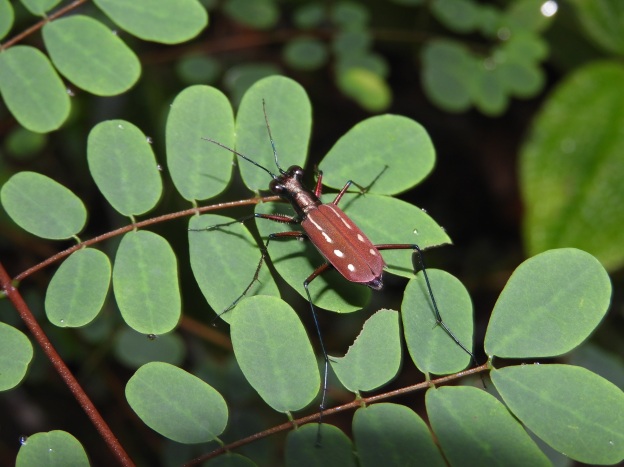
Eventually, we arrived at where I would hopefully see my number one target for the whole trip. The Serendib Scops Owl was first described as new to science in 2004 from this very rainforest, and it still remains the best place in the world to see it. However, it’s not easy to get to! First, we had to descend a steep and slippery slope to get down into a very large ditch, and then we had to wade through treacherous mud and dodge very thorny vines for quite a while. It certainly all paid off however, as we were treated to excellent views of not one but two of these brilliant owls roosting in the giant ferns. I think this was the highlight of my entire Sri Lankan holiday, being able to look right into the eyes of a ‘mythical’ bird.
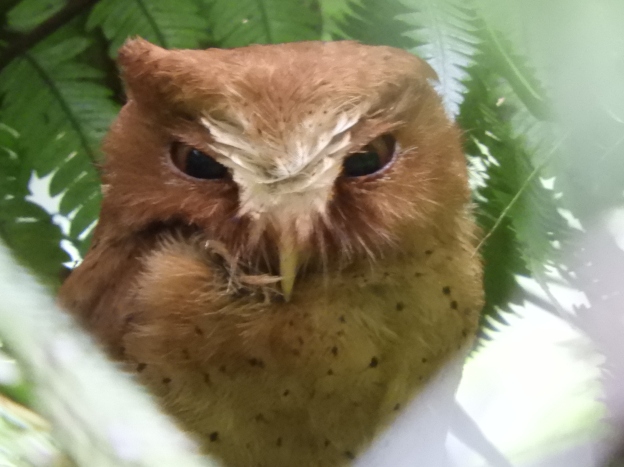
Serendib Scops Owl
The next day was very similar; however we were focused on the two species we had left to see: the Sri Lanka Scaly Thrush and the Sri Lanka Spurfowl. Being perhaps the hardest of all the endemics to see, I knew it was going to be a challenge. There were a few known places where the former could be seen, and I was eager to try some out. The first is just beside the path not too far from the entrance, and it appeared we were in luck when we heard one calling. The call is not loud and not distinctive either, and the bird was clearly moving. We crept along as silently and as quickly as we could in order to catch up to the bird, which was clearly moving unseen along the dark forest floor in front of us and to our left.
Eventually, we spotted a movement. We had caught up with the bird quicker than we anticipated. It was feeding just behind a patch of plants in front of us, right next to the path. I eased forward as slowly as I could manage, in order to get a good view of it. I have never seen a bird so camouflaged! The scales that give it its name really allow it to blend into the forest floor. Despite being only 10 metres away, if I took my eyes off it, it would take some finding to re-locate it! Not only were we able to watch it feeding so well but it also hopped up a log and flew into a tree, where it perched in the open quite high up. For an almost completely ground-dwelling species, this really was a special encounter!
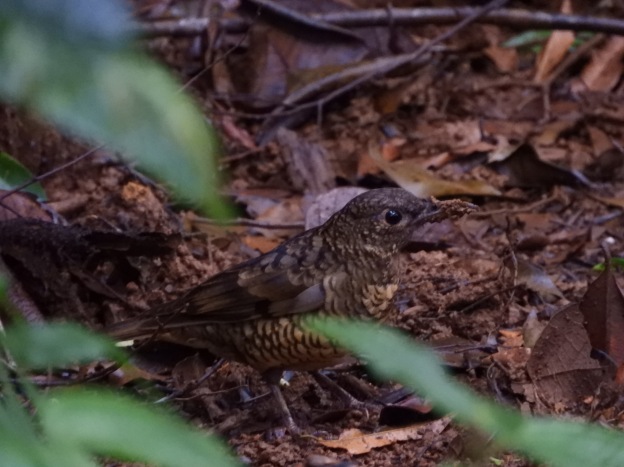
Scaly Thrush
The time of this sighting was only around mid-morning, so we were off to a good start. However, despite marvelling at a superb array of rainforest wildlife, the Sri Lanka Spurfowl eluded us for the whole day. As we headed back down the bumpy track to our lodge, I thought that we would have seen 33 out of the 34 endemics, which I wasn’t too displeased about.
Originally, I had planned to have a lie in on our final morning before heading back to the airport hotel. However, I’m glad I changed my mind at 6am! I knew I couldn’t miss the pre-breakfast bird walk, just in case something exciting was seen. You never know! And it turned out that I made the right decision…
We walked along the road from our lodge, seeing many common birds such as Green Imperial Pigeons and Thick-billed Flowerpeckers. It’s not a large or dense village, with very few houses, and soon we were walking along a cobbled road through thick forest towards some outlying buildings. Unlike the Scaly Thrush, Sri Lanka Spurfowls are very territorial and have a very loud call, which starts low but builds to a climax as the pair are duetting. Suddenly, we heard it rise up from the depths of the forest, I couldn’t quite believe it at first! They sounded quite far off but they were getting closer, toward an area of open ground beside a stream. We kept our eyes on that area of open ground and sure enough, two spurfowls walked into view! They were quite distant, however they completed our set of endemics for the trip, which I was elated about. A super end to a super trip!
